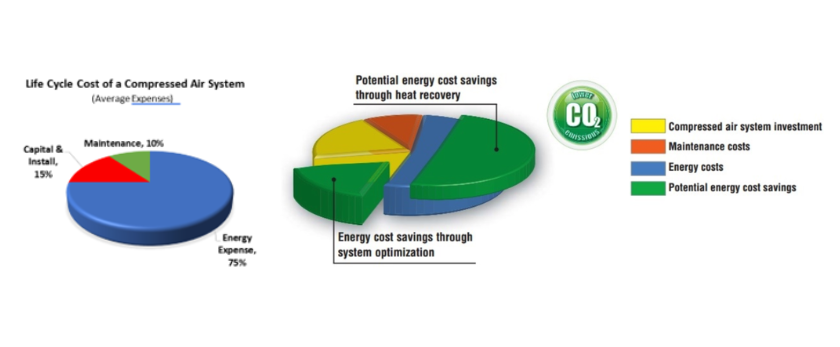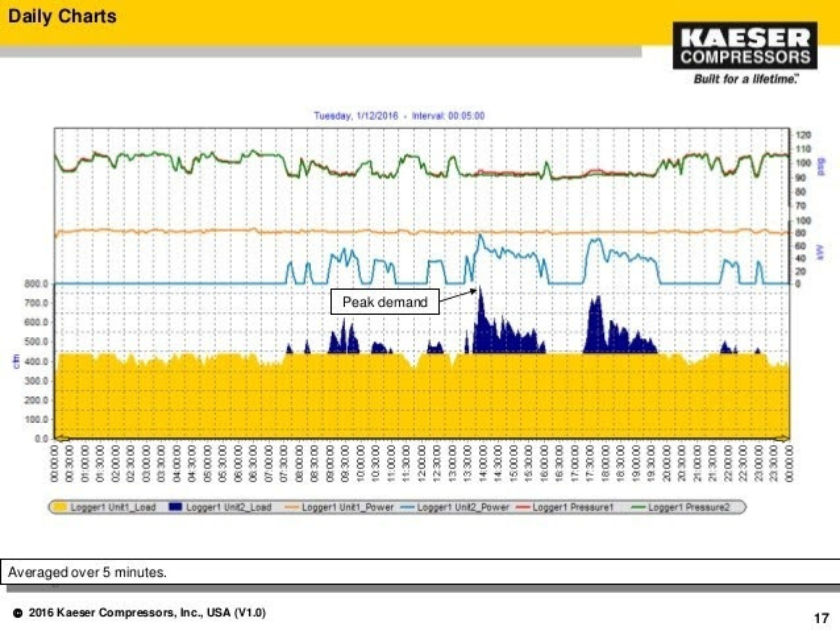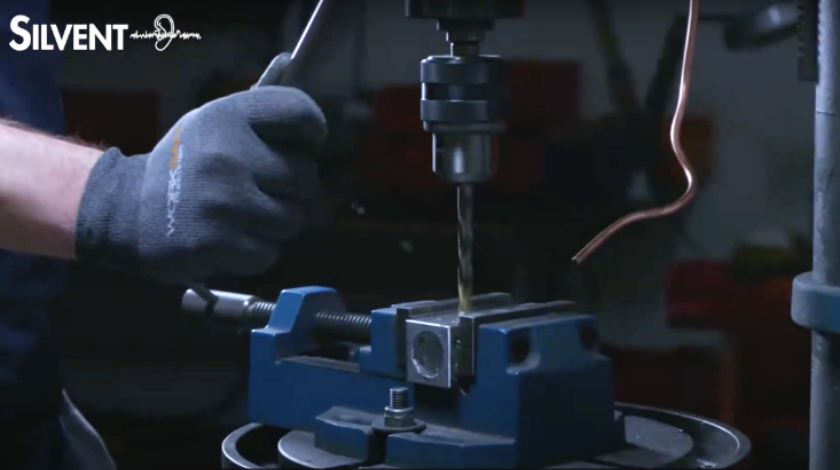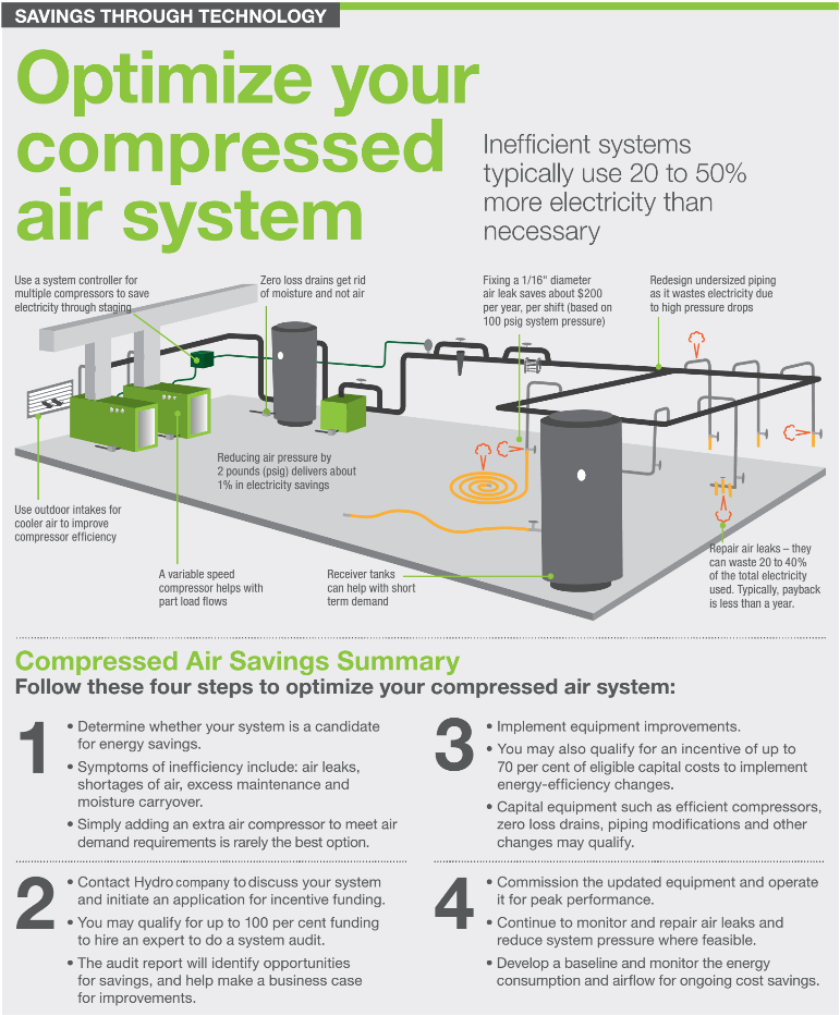 As industries increasingly prioritize their focus on sustainability and operational efficiency, the realization that the energy consumed, and often wasted in compressed air systems presents a tremendous opportunity to reduce costs. Compressed air is an essential, and integral part of most manufacturing and production processes and facilities - however, compressed air generation comes at a significant energy cost. In this comprehensive guide, we will explore the latest best practice strategies for conserving and enhancing energy efficiency in compressed air systems, utilizing proven and time-tested technologies. Our objective is to assist you in developing sustainable cost-saving practices to achieve tangible results.
As industries increasingly prioritize their focus on sustainability and operational efficiency, the realization that the energy consumed, and often wasted in compressed air systems presents a tremendous opportunity to reduce costs. Compressed air is an essential, and integral part of most manufacturing and production processes and facilities - however, compressed air generation comes at a significant energy cost. In this comprehensive guide, we will explore the latest best practice strategies for conserving and enhancing energy efficiency in compressed air systems, utilizing proven and time-tested technologies. Our objective is to assist you in developing sustainable cost-saving practices to achieve tangible results.
Compressed air systems are commonplace in most industrial settings, powering tools, machinery, valves, and production equipment. Data we have collected, and case studies, confirm that with no formal monitored management program, at a business, or company, compressed air can literally disappear into thin air. Experts estimate that up to 30% of the energy consumed by industrial facilities is attributed to compressed air system leaks. This significant energy consumption underscores the importance of end users performing an analysis to ensure that they fully understand, and appreciate, the extent of what their compressed air system is costing their business to own and operate. At the same time, system monitoring will highlight, and validate, the impact compressed air is having on bottom line profits. Analysis is key to identifying, and confirming production efficiency, equipment size and suitability, environmental impact and the consumption of flow, pressure loss, and Hydro power.

Identifying Opportunities for Improvement
Before implementing and investing in energy-saving measures, it is essential to conduct a comprehensive assessment of your compressed air system to create a benchmark from which to base case from. An air audit, also referred to as an Air Demand Analysis (ADA), facilitated by professionals like Air Solutions Canada, provides beneficial insights into system performance and identifies areas for improvement. Utilizing data logging equipment, and pressure transducers, our energy specialist technicians monitor energy consumption, system pressure, and cfm flow over a 9-day period. This results in data collection over two (2) weekends and five (5) days of production. The collected data is then analyzed, by a P. Eng, to pinpoint inefficiencies and potential energy-saving opportunities. Based on the production levels today, and the future prospective forecast for the facility, we offer several recommended improvements, alterations, or retro fits. Now we have a fact and data based “benchmark” to launch from, and a target to aim for, we can also capture incentive rebate funding.
As a channel partner for the Ontario Save on Energy program, Air Solutions Canada has a 100% success rate of applying for, and securing, Save on Energy retrofit rebate funding for our clients. Not a handful, more than 525. As a value-added service we facilitate the entire rebate application process, and paperwork on behalf of businesses, like yours, to ensure that we capture and capitalize on the funding available.
Our value proposition is further enhanced by our in-house capabilities. After collecting data, and performing an ADA air audit, our energy experts will design, build, install, and service everything required to reduce the cost of compressing air at your business. IT’S a “TURN-KEY” PROCESS.

Addressing Common Challenges
One of the primary causes of energy waste in compressed air systems is air leaks. During an Air Demand Analysis study, we recommend that the air compressors are left on, and remain running, throughout the data logging period. This is particularly prudent when the plant is closed, or production has been completed. The compressors will continue to run, and the data loggers will record the amount of volume being consumed by superficial uses and leaks. The ADA results will confirm the exact amount of compressed air being wasted, while calculating the cost of Hydro power required to feed the superficial consumption and losses.
Experience confirms that even minor leaks can result in substantial energy losses over time, driving up operating costs, and reducing system efficiency. Additionally, pressure drops within the system can lead to increased energy consumption, ranging from 20 to 50%, as compressors work harder to maintain optimal pressure levels. By conducting a thorough leak detection study, repairing the leaks, and implementing preventative maintenance measures, businesses can mitigate these challenges and achieve significant energy savings.
A leak detection study is an excellent investment and implementing a repair schedule for the leaks you and your team discover will inevitably produce a fantastic, and rapid, ROI (Return on Investment).
This sheet indicates the potential electricity costs saved when compressed.
Air leaks are fixed due to a decrease in compressor’s throughput.


NOTES
1) Calculation based on 13.0 cents/ kWh and 4,160 running hours per year
2) Savings do not include the electricity demand rate cost that most companies pay. The demand rate can be as high as 30% per kWh.
Picking low hanging fruits within your compressed air could also include replacing timed solenoid drain traps with energy savvy zero compressed air loss auto drain traps.

FACT: Compressed air flowing through a ¼” orifice at 100 PSIG = 104 CFM
If we assume that your existing solenoid drain pulses every 2 minutes for 10 seconds through a ¼” orifice at 100 psig, the compressed air loss from this drain trap will be 104 cfm x 10 seconds / 2 minutes = 8.67 cfm
To generate 8.67 cfm of compressed air, at 100 psig, you will require approximately 1.4 kw, (1.9hp), of air compressor electric motor power.
If 1 kw costs your company $0.13 cents per kw per hour, we can calculate that the operating cost for a solenoid drain, over a 1-year period, assuming 365 days, running 24 hours per day, will be as follows:
$1,594.32 ÷ 2 = $797.16 of SAVINGS per solenoid replaced!!!
Save on Energy incentives are also available to assist you with the purchase of these drain traps.
Trust us when we say that saving energy and increasing efficiency within your compressed air station, and distribution network, is straight forward and quite simple. We are here and happy to help you in any way, shape or form. Many facilities we visit use compressed air to propel, cool, or eject their products. Compressed air is generated at relatively high pressure and then drastically regulated at the points of use.
Every 2psig of excessive “over pressure” results in a 1% hydro power consumption cost increase. 10psig over pressure adds 5% per annum to your hydro bill.
If this looks familiar, we have an alternative solution, which will help to reduce the dB(A) noise levels and decrease the amount of compressed air consumption.

Save on Energy rebate incentives are also available for nozzles and air knives.
Replacing outdated equipment with state-of-the-art, energy-efficient alternatives is a key component in enhancing energy efficiency in compressed air systems. Air Solutions Canada Inc specializes in installing premium, efficient air compressor stations that optimize energy usage while delivering reliable performance. Correctly sized air receiver storage vessels, smooth bore aluminum piping, low differential pressure drop filter assemblies and heat recovery systems are all available with relative ease and affordable investment.
Additionally, advancements in compressed air technology, such as master controllers, variable speed drives, low purge desiccant air dryers, and integrated control systems and air dryers, facilitate ease of use and enhanced control over energy consumption, further maximizing system efficiency.
Understanding the exact requirements of your demand and production patterns and habits are essential to selecting and installing the right size and type of equipment, all roads yet again lead us back to performing a study. Industrial air compressors are available for all types of applications, and one size, or type of compressor most definitely will not “fit all”.
As an example, a fixed-speed compressor, Kaeser or any other, will typically use its full motor horsepower (and, therefore, full kilowatt draw) when it is fully loaded and compressing air. When the machine achieves the desired system set pressure, it receives a signal to switch from load to idle. When it runs in idle mode, the power consumption is reduced by as much as 60 percent, compared to full load power consumption.
If we use a fixed-speed 75 horsepower Kaeser CSD compressor to demonstrate how this works, you will see that purchasing a variable speed compressor may not be the best solution for your facility, especially if the incoming power to the building is prone and susceptible to spikes, brown outs, swells, or line noise.
- 75 hp translates to 55 kW.
- At full load, a 75-hp Kaeser compressor consumes 55 kW. In idle, it only consumes 22 kW.
- If the plant operates 8,000 hours per year, the power consumption costs will be approximately $57,200 (55 kW x 8,000 hours x $0.13 for energy).
- Furthermore, the Kaeser compressor is factory set to run in “idle” for up to 4 minutes and then it will automatically stop. The hydro power consumption at this point is of course, ZERO.
- Adding air receiver storage will increase the likely hood of the compressor switching to “idle” and also boost the chance of the machine reverting to “stop”.
How does this compare to a variable speed drive machine? It goes without saying that the choice of compressor type is relative to the cfm consumption demands of each facility. However, the variable speed machine optimizes its energy benefit, and savings, in a very specific area of its performance bell curve, which is between 30 and 80% of its full load capacity. Most variable speed machines are also unable to run successfully at full load, and often struggle at very low loads.
Unlocking Energy Efficiency with Air Solutions Canada
Save on Energy offers a range of incentive programs tailored to various compressed air project types. The Retrofit Program provides options for upgrading equipment and implementing custom solutions, with a focus on simplistic application processes. The Save on Energy program utilizes multiple avenues for applying for incentives, making it simple, obtainable, and achievable.
For businesses seeking to conduct comprehensive audits, the Audit Funding Program offers incentives of up to $5,000, and these can be applied to the ADA study, (Air Demand Analysis). After all, we cannot improve what we don’t measure.
Alternatively, prescriptive rebates are easily obtainable for improvements such as:
- Replacing timed solenoid drain traps with zero compressed air loss #kaeserecodrains.
- Increasing air receiver storage tank capacity.
- Upgrading Nozzles and Air Knives with ones that consume less cfm volume with lower dB(A). #silventnozzles.
- Replacing Air Dryers with more energy efficient versions.
- Reducing system pressure drop, by virtue of modern day in-line filter assemblies.
- Reducing air compressor motor hp, or kW size.
All of the above can be applied for via a simple one (1) page application form, and each has a fixed incentive value.

For more ambitious energy-saving projects, there is a “Custom Incentives Program,” which provides much higher levels of incentives, to support businesses in achieving long-term sustainable energy saving goals. This program allows for funding of up to 50% of the total project cost, with a longer commitment to savings targets.
At Air Solutions Canada, we are committed to helping businesses unlock the full potential of energy efficiency in compressed air systems. Through our partnership with the Save on Energy program, we enable businesses to achieve sustainable savings while minimizing environmental impact. From conducting air audits to implementing energy-saving solutions, we provide comprehensive support at every step of the journey. Together, let's pave the way for a more sustainable future through energy-efficient practices and innovative technologies. We aren’t a supplier; we are a partner. Let’s collaborate and succeed together.

